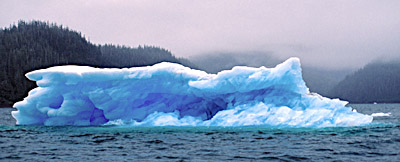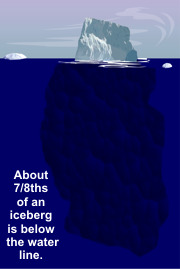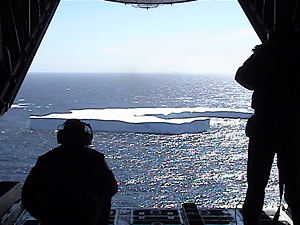Ice Bergs
 At 11:40 p.m. April 14, 1912, on a moonless, clear night with calm seas, HMS Titanic, billed as "practically unsinkable", struck an iceberg in the North Atlantic Ocean. It sank 2 hours, 40 minutes later at 2:20 a.m. the next day. Of the estimated 2,227 passengers on board, only 705 survived. This was her maiden voyage. Titanic was not the first ship to strike an iceberg nor was it the last. At 11:40 p.m. April 14, 1912, on a moonless, clear night with calm seas, HMS Titanic, billed as "practically unsinkable", struck an iceberg in the North Atlantic Ocean. It sank 2 hours, 40 minutes later at 2:20 a.m. the next day. Of the estimated 2,227 passengers on board, only 705 survived. This was her maiden voyage. Titanic was not the first ship to strike an iceberg nor was it the last.
Icebergs are blocks of fresh-water ice that break off, called "calving", from glaciers and float out to sea. Icebergs are found in both the Arctic and Antarctic regions but differ in form and size from each region. Icebergs in the Arctic regions are formed from mountain glaciers and are typically high and narrow. Called castle bergs, the above-water shapes resemble towers. In the Antarctic, large, and sometime enormous, flat-topped chunks of ice break off off ice shelves and are called tabular bergs. The Arctic produces 10,000 to 50,000 icebergs annually and normally have a four-year life-span.
 To be classified as an iceberg, the ice must originate from glaciers or shelf ice. The height must be greater than 15 feet (5 meters) above sea-level, the thickness must be 95-160 feet (30-50 meters), and the area must cover at least 1,500 square feet (500 square meters). There are smaller pieces of ice known as bergy bits and growlers. Bergy bits and growlers can originate from glaciers or shelf ice, and may also be the result of a large iceberg that has broken up. To be classified as an iceberg, the ice must originate from glaciers or shelf ice. The height must be greater than 15 feet (5 meters) above sea-level, the thickness must be 95-160 feet (30-50 meters), and the area must cover at least 1,500 square feet (500 square meters). There are smaller pieces of ice known as bergy bits and growlers. Bergy bits and growlers can originate from glaciers or shelf ice, and may also be the result of a large iceberg that has broken up.
Icebergs are typically white or light blue. The white color is from the snow sitting on the berg. The light blue is due to the scattering of blue light, much the same way the sky is blue. However, there are also stripped icebergs in which, during its formation, different colored earthy materials become imbedded in the ice.
A bergy bit is classified as a medium to large fragment of ice. Its height is generally greater than 3 feet (1 meter) but less than 15 feet (5 meters) above sea-level and its area is normally about 300-900 square feet (100-300 square meters).
Growlers are smaller fragments of ice and are roughly the size of a truck or grand piano. They are often transparent but can appear green or black in color. They extend less than 3 feet (1 meter) above the sea surface and occupy an area of about 60 square feet (20 square meters). The green color comes from algae that grows on the submerged portion that becomes exposed when it rolls over into view.
Icebergs are just as much a threat to the shipping industry today as they were in 1912. Ship Masters are weary of even the seemingly smallest pieces of ice near their vessel. As a result of the sinking of the RMS Titanic, U.S. Coast Guard ice patrols were begun to chart the location of icebergs. Up to World War II, ice patrols were routinely performed by ships. After the war, aerial surveillance became the primary ice reconnaissance method.
 Today, it is the basic Coast Guard authority to operated the International Ice Patrol (IIP). Their mission is to monitor iceberg dangers near the Grand Banks of Newfoundland and provide the limits of all known ice to the maritime community. Ships in the vicinity of the "limits of all known ice" normally will pass just to the south of this boundary. Today, it is the basic Coast Guard authority to operated the International Ice Patrol (IIP). Their mission is to monitor iceberg dangers near the Grand Banks of Newfoundland and provide the limits of all known ice to the maritime community. Ships in the vicinity of the "limits of all known ice" normally will pass just to the south of this boundary.
Vessels passing through the Ice Patrol's published ice limit run the risk of a collision with an iceberg. In this area, the Labrador Current meets the warm Gulf Stream. The temperature differences between the two water masses can reach up to 36°F (20°C), which often results in dense fog. The combination of icebergs, fog, severe storms, fishing vessels, and busy Trans-Atlantic shipping lanes makes this area one of the most dangerous to navigate through.
Partnered with the International Ice Patrol is the National Ice Center (NIC). The NIC is a unique U.S. government interagency, as it is composed of U.S. Navy, USCG, and NOAA active duty and civilian personnel. While the IIP, through the USCG, monitors iceberg activity in the trans-Atlantic shipping lanes, the NIC monitors iceberg activity around Antarctica (http://www.natice.noaa.gov/products/iceberg/index.htm). The NIC also provides operational support to the IIP through the USCG year-round. |
| Back: Seawater |
|
National Weather Service
Southern Region Headquarters
819 Taylor Street
Fort Worth, Texas 76102 |
www.srh.weather.gov
Updated: March 29, 2006 |
|





